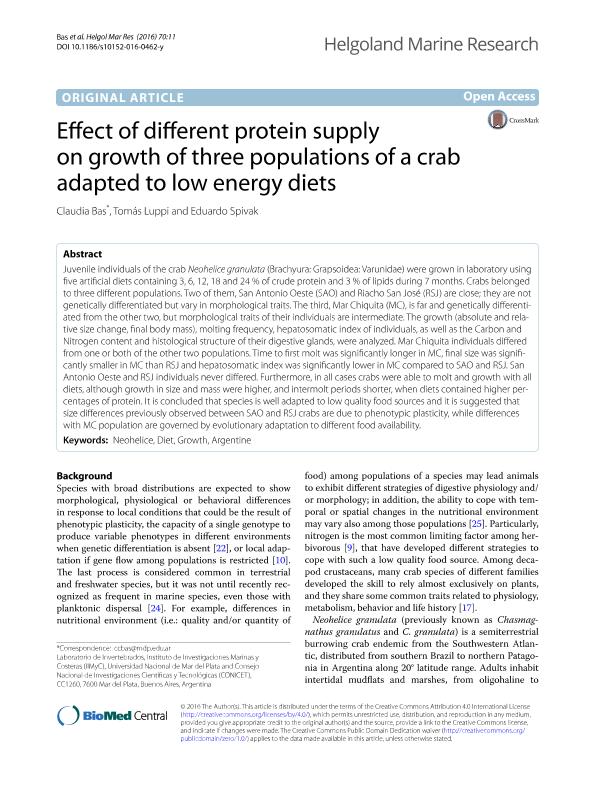Artículo
Effect of different protein supply on growth of three populations of a crab adapted to low energy diets
Fecha de publicación:
12/2016
Editorial:
Springer
Revista:
Helgoland Marine Research
ISSN:
1438-387X
Idioma:
Inglés
Tipo de recurso:
Artículo publicado
Clasificación temática:
Resumen
Juvenile individuals of the crab Neohelice granulata (Brachyura: Grapsoidea: Varunidae) were grown in laboratory using five artificial diets containing 3, 6, 12, 18 and 24 % of crude protein and 3 % of lipids during 7 months. Crabs belonged to three different populations. Two of them, San Antonio Oeste (SAO) and Riacho San José (RSJ) are close; they are not genetically differentiated but vary in morphological traits. The third, Mar Chiquita (MC), is far and genetically differentiated from the other two, but morphological traits of their individuals are intermediate. The growth (absolute and relative size change, final body mass), molting frequency, hepatosomatic index of individuals, as well as the Carbon and Nitrogen content and histological structure of their digestive glands, were analyzed. Mar Chiquita individuals differed from one or both of the other two populations. Time to first molt was significantly longer in MC, final size was significantly smaller in MC than RSJ and hepatosomatic index was significantly lower in MC compared to SAO and RSJ. San Antonio Oeste and RSJ individuals never differed. Furthermore, in all cases crabs were able to molt and growth with all diets, although growth in size and mass were higher, and intermolt periods shorter, when diets contained higher percentages of protein. It is concluded that species is well adapted to low quality food sources and it is suggested that size differences previously observed between SAO and RSJ crabs are due to phenotypic plasticity, while differences with MC population are governed by evolutionary adaptation to different food availability.
Palabras clave:
ARGENTINE
,
DIET
,
GROWTH
,
NEOHELICE
Archivos asociados
Licencia
Identificadores
Colecciones
Articulos(IIMYC)
Articulos de INSTITUTO DE INVESTIGACIONES MARINAS Y COSTERAS
Articulos de INSTITUTO DE INVESTIGACIONES MARINAS Y COSTERAS
Citación
Bas, Claudia Cristina; Luppi, Tomas Atilio; Spivak, Eduardo Daniel; Effect of different protein supply on growth of three populations of a crab adapted to low energy diets; Springer; Helgoland Marine Research; 70; 1; 12-2016; 1-10
Compartir
Altmétricas




